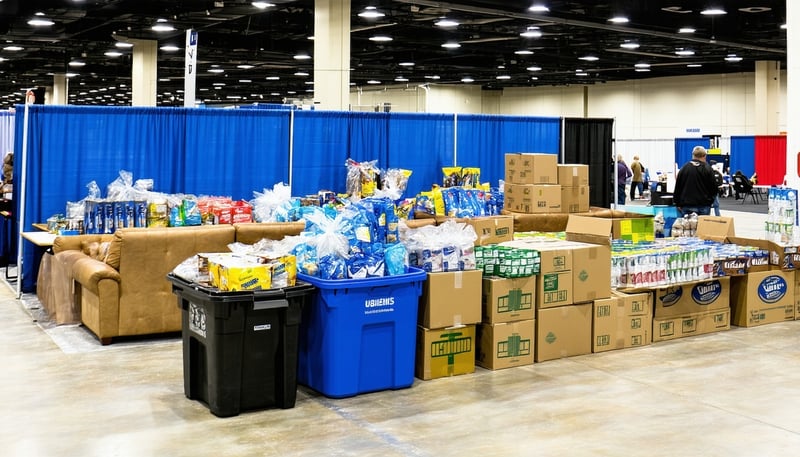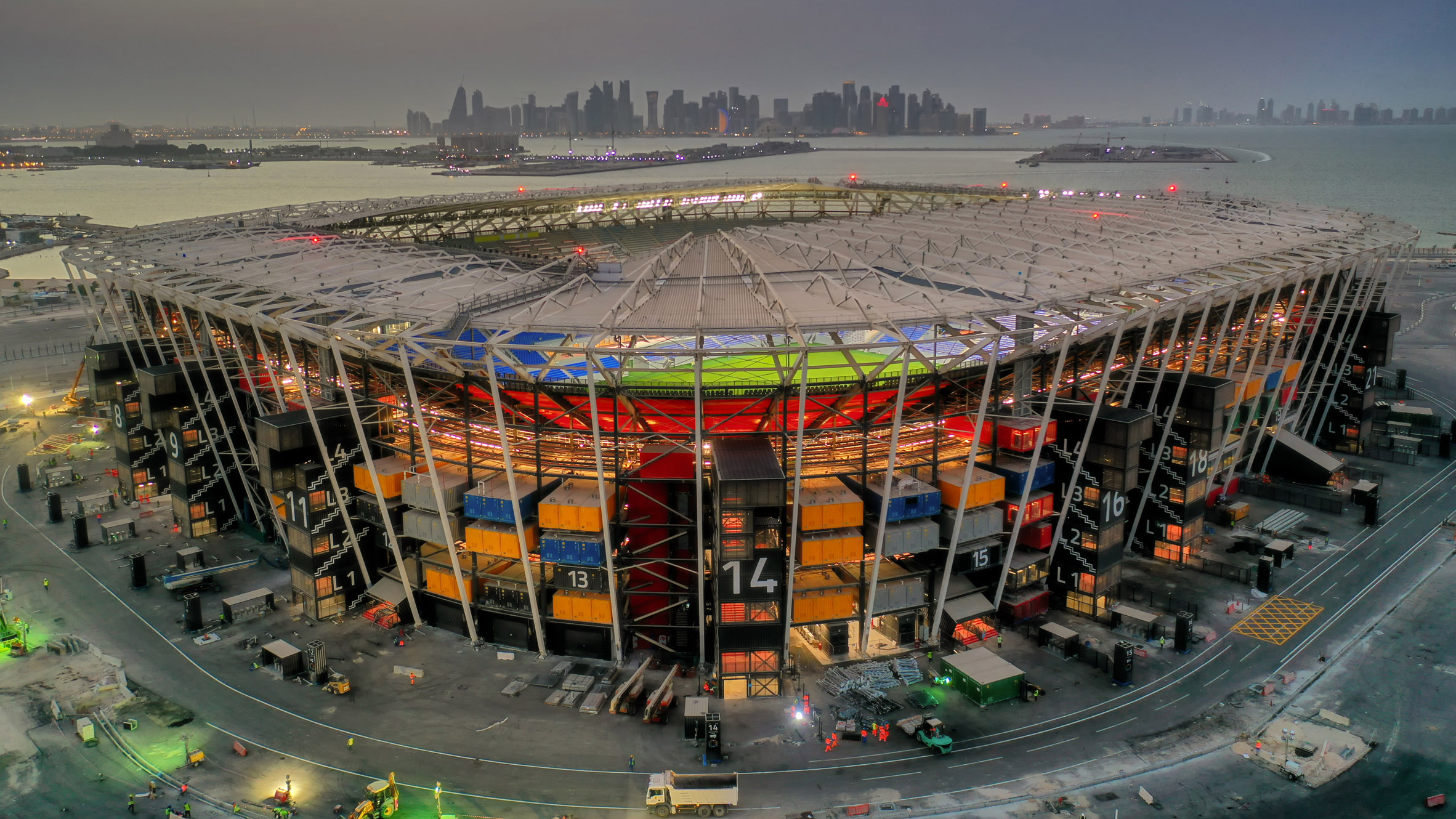In recent years, sports stadiums have rapidly evolved into showcases of environmental innovation....
The Waste Problem at Trade Shows and Conferences: Seven Zero Waste Strategies for Sustainable Event Planning
On average, events generate 2.5 pounds of landfill waste per person, per day. That adds up fast. A three-day, 8,000-person customer conference produces around 60,000 pounds of trash. That’s roughly 30 tons, or the weight of five adult elephants. A single-day trade show with 40,000 attendees creates about 100,000 pounds, or 50 tons of waste, which is the equivalent of a fully loaded semi-truck heading straight to landfill.
Zoom out to the industry level, and the scale becomes staggering. The U.S. live music industry alone generates 53,000 tons of waste each year, which is more than the annual waste output of a city of 100,000 people. Add in the 31,000 trade shows hosted globally every year, many drawing tens of thousands of attendees, and total waste climbs into the millions of tons annually. Much of it is avoidable.

To put it in perspective:
- One large event can create more waste in a day than a small town does in a week.
- The annual waste from live music events equals the weight of more than 300 Boeing 747s.
- Global trade shows generate enough waste to fill over 20,000 garbage trucks every year.
This visible waste is only the beginning. Behind it lie deeper issues: carbon emissions, lost economic value, rising operational costs, and growing attendee dissatisfaction.
As a global event planner, I have had moments where I felt powerless in the face of these challenges. But I have also learned that we hold more power than we think. With the right strategies and venue partners, we can lead a shift toward sustainable events that are not only climate-conscious but also economically smart and more engaging for attendees. The time to act is now. Studies show that more than 70 percent of attendees prefer sustainably organized events. Millennials and Gen Z attendees are even willing to pay more for event experiences that reflect their environmental values.
This blog outlines practical strategies for reducing event waste and planning zero waste events that protect both your brand and the planet.
Why the Traditional Event Model Creates Waste
Most events still follow a take-make-waste model. Materials and services are sourced, consumed, and then discarded. This linear system generates significant waste and emissions and creates inefficiencies across the entire value chain.
For venues and organizers, the impact shows up in higher costs, regulatory pressure, and missed opportunities to lead in event sustainability. Waste often falls into Scope 3 emissions, meaning the emissions are tied to your event but occur outside your direct control. Addressing these emissions requires early planning, shared responsibility, and collaboration across the supply chain.
Seven Strategies for Planning Zero Waste Events

Planning a zero waste event takes forethought, collaboration, and a commitment to sustainability at every stage. Whether you're organizing a corporate conference, a community festival, or a trade show, these seven strategies will help you minimize your environmental impact and divert as much material from landfill as possible.
1. Start with a Waste Audit
Before you finalize any plans, do a thorough waste audit of your event. Think through every element—set-up, programming, catering, and break-down—and list the types of materials that will likely be discarded. Then, categorize them based on your zero waste hierarchy:
- Reduce (best option)
- Reuse (next best)
- Recycle (only if necessary)
This exercise will help you identify avoidable waste and prioritize sustainable alternatives early in the planning process.
2. Understand Your Venue's Waste Capabilities
Every venue is different, and understanding their waste infrastructure is crucial. Ask detailed questions about which waste streams they process (recycling, composting, landfill) and how they’re managed.
Can your team assist with sorting or signage to increase diversion? Do they require specific materials or colors for bins? This kind of proactive communication can dramatically improve recovery rates and reduce contamination.
3. Opt for Reusable Serviceware
Single-use items are one of the biggest sources of waste at events. Whenever possible, switch to reusable cups, plates, bowls, and cutlery. Many venues have dishwashing infrastructure onsite, or you can partner with a vendor that provides pickup, washing, and return services.
Set up clearly labeled drop-off stations so attendees know where to return their items.
Avoid “compostable” serviceware unless you’ve confirmed—in writing—that your venue’s waste hauler sends these items to an industrial composting facility. If they don’t, these materials will likely end up in the landfill and can even increase methane emissions.
4. Rent or Reuse Furniture

Resist the temptation to buy inexpensive, disposable furniture for one-time use. Instead, rent high-quality furniture or invest in pieces you can reuse at future events.
Encourage (or require) exhibitors to take all booth materials with them during break-down. While some venues offer donation programs for leftover furniture, these should be treated as a last resort. They require additional labor and coordination, and unfortunately, items often still end up in the landfill.
5. Donate Leftover Meals
Over-ordering food is a common issue at events—but wasted food doesn’t have to go to waste. Pre-packaged, refrigerated meals and shelf-stable snacks are ideal for donation.
First, ask your venue if they already have a meal donation program in place and opt in if they do. If not, partner with a local food recovery organization, such as Careit, to coordinate pickup in advance. Just a bit of planning can turn excess into impact.
6. Set Up Item Donation Bins
During move-out, attendees and vendors often discard office supplies, signage, electronics, and promotional merchandise. Rather than letting these items go to landfill, set up labeled donation bins in high-traffic areas.
Check if your venue has an existing donation program or create your own by partnering with local nonprofits, schools, or churches that accept gently used items. Be sure to plan for post-event pickup and sorting.
7. Communicate and Educate
A zero waste event is only as successful as the people behind it. Communicate your goals to attendees, staff, and vendors ahead of time. Include signage, announcements, and volunteer-led support at waste stations to guide proper disposal.
The more informed and engaged your community is, the more successful your waste diversion efforts will be.
Conclusion: You Can’t Improve What You Don’t Measure
Whether you're hosting an event or providing the space, meaningful change starts with visibility and story-telling. You can’t improve what you don’t measure—so start by tracking energy, water, and waste at each event. With a software like Envire, venues can automate data collection and share actionable, event-specific insights with event organizers. When staff are freed from manual data crunching, they can turn their focus to improving infrastructure, identifying cost-savings opportunities, and ensuring customer satisfaction.
Sustainability doesn’t mean compromising on experience or innovation. On the contrary—it’s a chance to design smarter, create more meaningful connections, and ensure the events industry remains vibrant and viable for generations to come.






Have questions? Reach out to our authors!